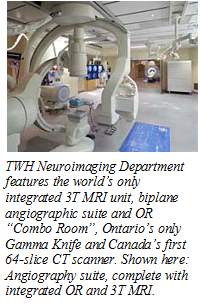
Toronto (Oct. 26, 2005) - When you combine state of the art technology with some of the world's brightest minds, something magical happens. For the University Health Network's Toronto Western Hospital (TWH), this magic is the creation of Canada's foremost Neuroimaging Department.
Five years ago, TWH envisioned a department to improve the care of its over 30,000 patients who suffer from an array of neural diseases and disorders. Whether it's a man having a stroke or a woman struggling with Parkinson's, having a clear perspective of the brain and it's functions would be key. As such, TWH set its sights on having access to most advanced medical equipment and technology in the world.
Today, thanks to the generous support of donors, UHN funds and the endorsement of the Ministry of Health and Long-Term Care, TWH's vision is becoming a reality. TWH Neuroimaging Department now features the world's only integrated 3T MRI unit, biplane angiographic suite and OR "Combo Room", Ontario's only Gamma Knife and Canada's first 64-slice CT scanner. It's through this technology that its world-renowned neuroradiologists, neurologists and neurosurgeons can trace fine nerve fibers, pin point a tumor deep in the brain or fix a brain aneurism minimally invasively.
"We create 4D virtual rendering of the brain anatomy with inframillimetric accuracy," says Dr. Karel TerBrugge, Head, Division of Neuroradiology, TWH. "By improving our view, we improve our guidance and treatment capability; and this can mean better outcomes for the patient and their families."
Housed on the 3rd floor, the Medical Imaging Department was custom designed to minimize the movement of patients between areas and maximize operational efficiency. The MRI and CT suites each share a control room which can be safely operated by only one technician and the Combo Room responds to the specialized need of stroke patients.
"If you are a stroke patient every second counts," say Dr. TerBrugge. "By decreasing the distance a patient needs to move throughout the hospital for diagnosis and treatment – as is the case with the Combo Room - we are making the most of every second."
Better technology also translates into improved access for all patients. As the first hospital in Ontario to operate its MRI suites on a 24/7 basis, UHN understands the importance of access.
"In 1975, it took 45 minutes to complete a head CT scan and the result was four black and white images. With a 64-slice CT scanner we can scan a head in just five seconds and a volume of (isotropic) data that can be rendered in 3D or 4D models," says Dr. Patrice Bret, Chief, Radiology, UHN and Mount Sinai. "This means we can do more scans in a day, while also achieving better results."
This neuroimaging department however isn't complete, and as long as technology continues to advance, so will its vision for improving patient care.
"We are in the process of establishing a solution driven research imaging centre to work side by side with the Medical Imaging department and already have our sights set on a 7T MRI, a Magnetoencephalography (MEG) System and a Neuro PET scanner," says Dr. Bret. "To make it happen we just need the funds and the space."
Each year through its Krembil Neuroscience Program, the Toronto Western Hospitals treats more than 30,000 patients and 2,500 neurosurgical operations are performed. The Krembil Neuroscience Centre is one of the largest combined clinical and research neurological facilities in North America. The Toronto Western Hospital is a member of the University Health Network, which also includes the Toronto General Hospital and Princess Margaret Hospital. All three are teaching hospitals affiliated with the University of Toronto.
